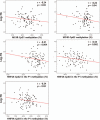MC4R and HNF4α promoter methylation at birth contribute to triglyceride levels in childhood: A prospective cohort study
- PMID: 31305461
- PMCID: PMC6641802
- DOI: 10.1097/MD.0000000000016424
MC4R and HNF4α promoter methylation at birth contribute to triglyceride levels in childhood: A prospective cohort study
Abstract
Although the changes in DNA methylation are assumed to be due to the association between adverse intrauterine conditions and adult metabolic health, evidence from human studies is rare. Little is known about the changes in DNA methylation present at birth that affect metabolic profiles in childhood. Previous studies have shown that the melanocortin 4 receptor (MC4R) and hepatocyte nuclear factor 4 alpha (HNF4α) genes are associated with obesity and metabolic disorders. Thus, we investigated the associations of the DNA methylation statuses of MC4R and HNF4α in cord blood with metabolic profiles in childhood.We collected data from 90 children 7 to 9 years of age included in the Ewha Birth & Growth Cohort Study in Korea. DNA methylation was analyzed by pyrosequencing. The children were split into 2 groups according to the cutoff triglyceride (TG) levels (<110 and ≥110 mg/dL).The methylation statuses of MC4R and HNF4α at birth were significantly associated with the TG level in childhood (P < .05). It was interesting to note that the methylation statuses of MC4R and HNF4α in cord blood were significantly decreased, whereas childhood body mass index was significantly increased, in children with high TG levels compared with children with low TG levels (P < .05).Our findings show that the methylation statuses of MC4R and HNF4α at birth are associated with metabolic profiles in childhood. These epigenetic modifications occurring in early life may contribute to subsequent metabolic-related disorders. Thus, we suggest that DNA methylation status in cord blood may be predictive of the risk of developing metabolic syndrome.
Conflict of interest statement
The authors have no conflicts of interest to disclose.
Figures


Similar articles
-
From Mother to Child: Epigenetic Signatures of Hyperglycemia and Obesity during Pregnancy.Nutrients. 2024 Oct 16;16(20):3502. doi: 10.3390/nu16203502. Nutrients. 2024. PMID: 39458497 Free PMC article.
-
DNA methylations of MC4R and HNF4α are associated with increased triglyceride levels in cord blood of preterm infants.Medicine (Baltimore). 2016 Aug;95(35):e4590. doi: 10.1097/MD.0000000000004590. Medicine (Baltimore). 2016. PMID: 27583872 Free PMC article.
-
Association between the DNA methylations of POMC, MC4R, and HNF4A and metabolic profiles in the blood of children aged 7-9 years.BMC Pediatr. 2018 Mar 29;18(1):121. doi: 10.1186/s12887-018-1104-0. BMC Pediatr. 2018. PMID: 29598821 Free PMC article.
-
Maternal corticotropin-releasing hormone is associated with LEP DNA methylation at birth and in childhood: an epigenome-wide study in Project Viva.Int J Obes (Lond). 2019 Jun;43(6):1244-1255. doi: 10.1038/s41366-018-0249-0. Epub 2018 Nov 21. Int J Obes (Lond). 2019. PMID: 30464231 Free PMC article.
-
A systematic review and metaanalysis of observational studies on the effects of epigenetic factors on serum triglycerides.Arch Endocrinol Metab. 2022 May 13;66(3):407-419. doi: 10.20945/2359-3997000000472. Epub 2022 May 12. Arch Endocrinol Metab. 2022. PMID: 35551677 Free PMC article.
Cited by
-
The Obesogenic Environment: Epigenetic Modifications in Placental Melanocortin 4 Receptor Gene Connected to Gestational Diabetes and Smoking.Front Nutr. 2022 Apr 29;9:879526. doi: 10.3389/fnut.2022.879526. eCollection 2022. Front Nutr. 2022. PMID: 35571924 Free PMC article.
-
From Mother to Child: Epigenetic Signatures of Hyperglycemia and Obesity during Pregnancy.Nutrients. 2024 Oct 16;16(20):3502. doi: 10.3390/nu16203502. Nutrients. 2024. PMID: 39458497 Free PMC article.
-
Cohort profile: the Ewha Birth and Growth Study.Epidemiol Health. 2021;43:e2021016. doi: 10.4178/epih.e2021016. Epub 2021 Feb 22. Epidemiol Health. 2021. PMID: 33677859 Free PMC article.
References
-
- Alberti KG, Eckel RH, Grundy SM, et al. Harmonizing the metabolic syndrome: a joint interim statement of the International Diabetes Federation Task Force on Epidemiology and Prevention; National Heart, Lung, and Blood Institute; American Heart Association; World Heart Federation; International Atherosclerosis Society; and International Association for the Study of Obesity. Circulation 2009;120:1640–5. - PubMed
-
- Ministry of Health and Welfare. Korea Centers for Disease Control and, Prevention. Korea Health Statistics 2010: Korea National Health and Nutrition Examination Survey, (KNHANESV-1). Cheongwon: Ministry of Health and Welfare, 2011
-
- Eisenmann JC, Welk GJ, Wickel EE, et al. Stability of variables associated with the metabolic syndrome from adolescence to adulthood: the aerobics center longitudinal study. Am J Hum Biol 2004;16:690–6. - PubMed
-
- Katzmarzyk PT, Perusse L, Malina RM, et al. Stability of indicators of the metabolic syndrome from childhood and adolescence to young adulthood: the Quebec Family Study. J Clin Epidemiol 2001;54:190–5. - PubMed
MeSH terms
Substances
LinkOut - more resources
Full Text Sources
Miscellaneous

